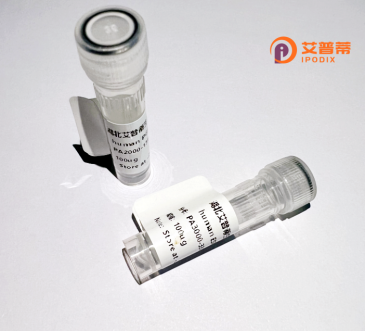
| 纯度 | >90%SDS-PAGE. |
| 种属 | Human |
| 靶点 | NCKAP1 |
| Uniprot No | Q9Y2A7 |
| 内毒素 | < 0.01EU/μg |
| 表达宿主 | E.coli |
| 表达区间 | 1-1128 aa |
| 活性数据 | MSRSVLQPSQQKLAEKLTILNDRGVGMLTRLYNIKKACGDPKAKPSYLIDKNLESAVKFIVRKFPAVETRNNNQQLAQLQKEKSEILKNLALYYFTFVDVMEFKDHVCELLNTIDVCQVFFDITVNFDLTKNYLDLIITYTTLMILLSRIEERKAIIGLYNYAHEMTHGASDREYPRLGQMIVDYENPLKKMMEEFVPHSKSLSDALISLQMVYPRRNLSADQWRNAQLLSLISAPSTMLNPAQSDTMPCEYLSLDAMEKWIIFGFILCHGILNTDATALNLWKLALQSSSCLSLFRDEVFHIHKAAEDLFVNIRGYNKRINDIRECKEAAVSHAGSMHRERRKFLRSALKELATVLSDQPGLLGPKALFVFMALSFARDEIIWLLRHADNMPKKSADDFIDKHIAELIFYMEELRAHVRKYGPVMQRYYVQYLSGFDAVVLNELVQNLSVCPEDESIIMSSFVNTMTSLSVKQVEDGEVFDFRGMRLDWFRLQAYTSVSKASLGLADHRELGKMMNTIIFHTKMVDSLVEMLVETSDLSIFCFYSRAFEKMFQQCLELPSQSRYSIAFPLLCTHFMSCTHELCPEERHHIGDRSLSLCNMFLDEMAKQARNLITDICTEQCTLSDQLLPKHCAKTISQAVNKKSKKQTGKKGEPEREKPGVESMRKNRLVVTNLDKLHTALSELCFSINYVPNMVVWEHTFTPREYLTSHLEIRFTKSIVGMTMYNQATQEIAKPSELLTSVRAYMTVLQSIENYVQIDITRVFNNVLLQQTQHLDSHGEPTITSLYTNWYLETLLRQVSNGHIAYFPAMKAFVNLPTENELTFNAEEYSDISEMRSLSELLGPYGMKFLSESLMWHISSQVAELKKLVVENVDVLTQMRTSFDKPDQMAALFKRLSSVDSVLKRMTIIGVILSFRSLAQEALRDVLSYHIPFLVSSIEDFKDHIPRETDMKVAMNVYELSSAAGLPCEIDPALVVALSSQKSENISPEEEYKIACLLMVFVAVSLPTLASNVMSQYSPAIEGHCNNIHCLAKAINQIAAALFTIHKGSIEDRLKEFLALASSSLLKIGQETDKTTTRNRESVYLLLDMIVQESPFLTMDLLESCFPYVLLRNAYHAVYKQSVTSSA |
| 分子量 | 149.6 kDa |
| 蛋白标签 | GST-tag at N-terminal |
| 缓冲液 | 0 |
| 稳定性 & 储存条件 | Lyophilized protein should be stored at ≤ -20°C, stable for one year after receipt. Reconstituted protein solution can be stored at 2-8°C for 2-7 days. Aliquots of reconstituted samples are stable at ≤ -20°C for 3 months. |
| 复溶 | Always centrifuge tubes before opening.Do not mix by vortex or pipetting. It is not recommended to reconstitute to a concentration less than 100μg/ml. Dissolve the lyophilized protein in distilled water. Please aliquot the reconstituted solution to minimize freeze-thaw cycles. |
以下是关于重组人NCKAP1蛋白的模拟参考文献示例(仅供参考,实际文献需通过学术数据库查询):
---
1. **文献名称**:*"NCKAP1 regulates actin polymerization through interaction with the WAVE complex in cancer cell migration"*
**作者**:Chen L, et al.
**摘要**:本研究探讨了重组人NCKAP1蛋白在肿瘤细胞迁移中的作用,发现其作为WAVE复合体的关键成员,通过调控肌动蛋白的聚合影响细胞运动。体外实验表明,NCKAP1缺失显著抑制肿瘤细胞的侵袭能力。
2. **文献名称**:*"Structural and functional characterization of recombinant human NCKAP1 in neuronal development"*
**作者**:Wang Y, et al.
**摘要**:通过体外表达纯化重组人NCKAP1蛋白,分析其结构与功能。研究发现NCKAP1在神经元突触形成中与Rac1信号通路相互作用,并调控树突棘的动态重塑。
3. **文献名称**:*"NCKAP1 deficiency impairs T-cell immune response via dysregulation of WAVE2-mediated signal transduction"*
**作者**:Tanaka K, et al.
**摘要**:利用重组NCKAP1蛋白及基因敲除模型,揭示其在T细胞活化中的功能。NCKAP1通过稳定WAVE2复合体调控免疫突触形成,缺陷可导致适应性免疫反应减弱。
---
**注意**:以上内容为基于领域知识的模拟生成,实际文献需查阅PubMed、Web of Science或Google Scholar等平台(建议搜索关键词:*NCKAP1 recombinant protein* / *NCKAP1 function*)。
NCKAP1 (NCK-associated protein 1), also known as Hem-1. is a key component of the WAVE regulatory complex (WRC) that governs actin cytoskeleton reorganization. This scaffold protein contains multiple conserved domains, including an N-terminal NCK-binding region and a C-terminal WRC interaction motif. By linking cell surface receptors to actin dynamics, NCKAP1 facilitates critical cellular processes such as cell migration, immune synapse formation, and endocytosis through spatial-temporal regulation of Arp2/3-mediated actin polymerization.
Studies reveal its functional diversity across cell types: in hematopoietic cells, NCKAP1 coordinates immune cell trafficking and antigen presentation, while in neurons, it influences synaptic plasticity. Dysregulation of NCKAP1 is implicated in pathologies including cancers (e.g., acute myeloid leukemia), neurodevelopmental disorders like Helsmoortel-Van der Aa syndrome, and immunodeficiency diseases. Mutations disrupting NCKAP1-WRC assembly often impair cell motility and signal transduction.
Recombinant human NCKAP1 protein, typically produced in bacterial or mammalian expression systems, serves as an essential tool for studying WRC-dependent signaling pathways. Its applications range from in vitro actin polymerization assays to exploring therapeutic targets for metastasis or immune dysregulation. Recent structural analyses of recombinant NCKAP1 have further elucidated its dynamic role in autoinhibitory WRC activation mechanisms.
×